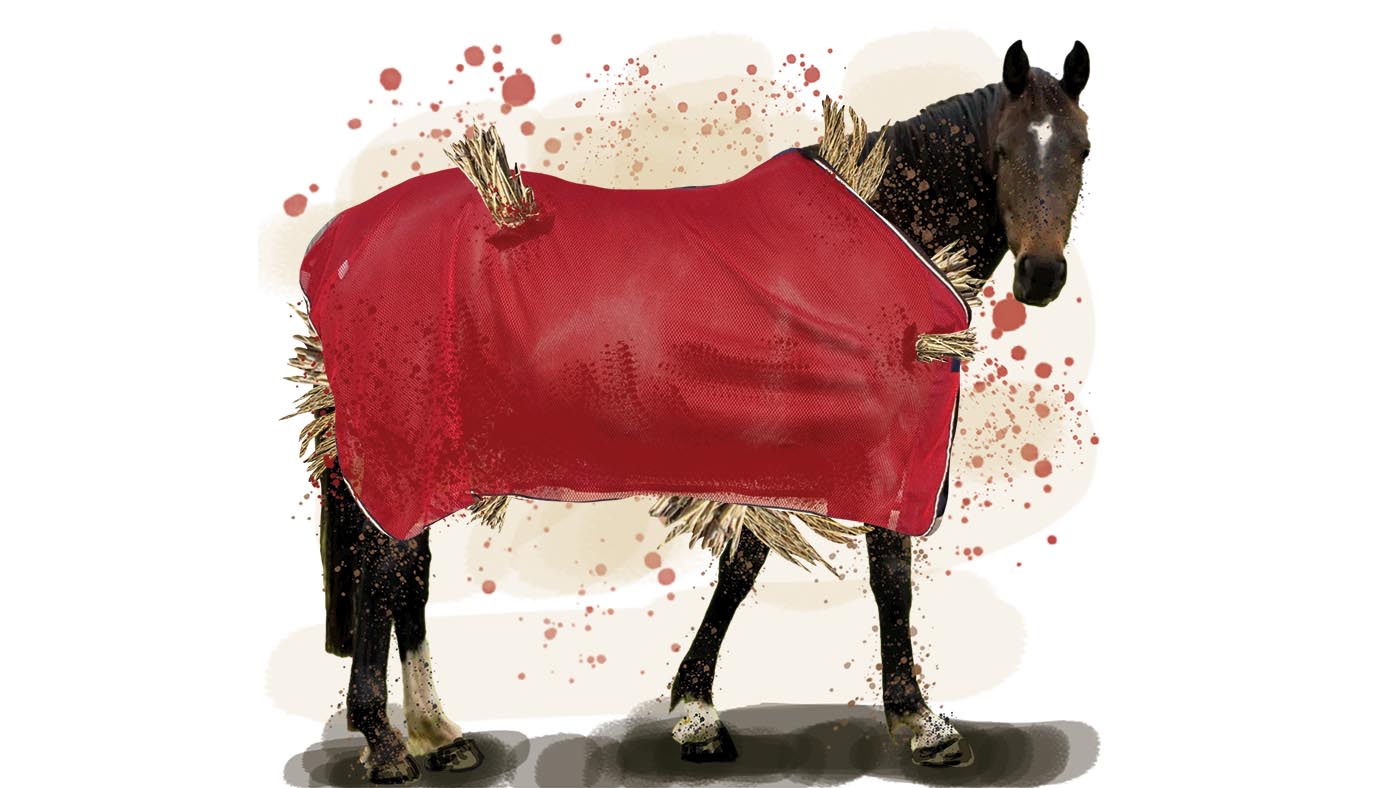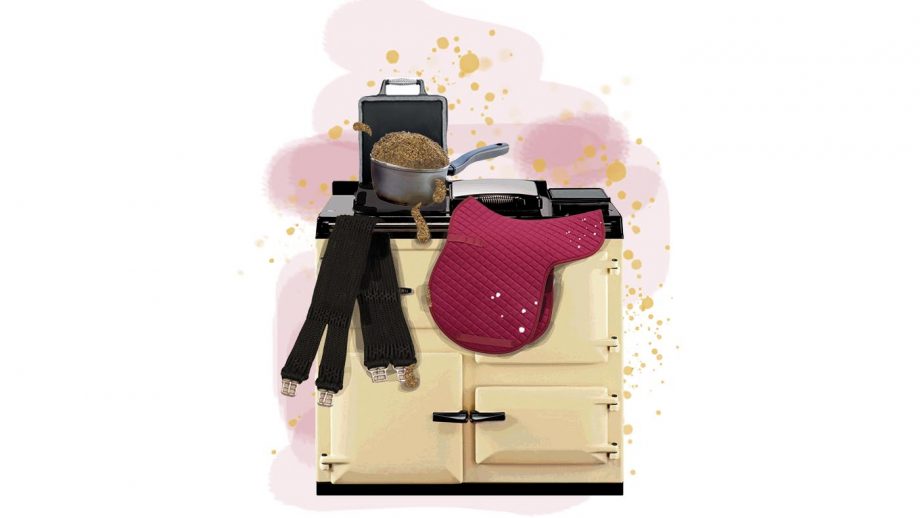Thatching, jute, kaolin and boiled linseed have almost gone out of our vocabulary, says Andrea Oakes, evoking memories of AGAs festooned in string girths with a cauldron bubbling for the horse’s dinner
Hay wisp
IT looked so easy in the Pony Club Manual of Horsemanship – simply make a long, tightly woven rope from hay, before fashioning it into two loops and twisting the loose end through these. If the resulting tangle looked anything like a hay wisp, you were ready to use it with vigorous strokes to massage the horse and produce a deep shine.
Sometimes called strapping or banging, this was once considered an essential part of grooming. Was it worth the effort?
“My mum taught me how to make a hay wisp and my grandfather taught her,” says former eventer Ginny Elliot. “We used to spend hours strapping the horses and we liked to think it made a difference.”
Eventing Olympian Mary King, who would instead use a folded cloth (then termed a stable rubber) to produce the satisfying “slaps” that stimulated muscled areas, adds: “It certainly gave me some muscles. When I worked for [international eventer] Sheila Willcox, she was a stickler for strapping. All the horses had to be strapped, 60 times on each side: 20 on the crest of the neck, 20 on the muscle above the elbows, 20 on the quarters.”
International dressage rider Richard Davison says: “Strapping was a relic of our upbringing, and until about 20 years ago we kept a hay wisp in every grooming kit. We now know a bit more about muscle development, however; I’m not sure it was particularly effective.”
Richard admits that as a youngster working in a racing yard, he found an easier alternative.
“We would just pretend, making the strapping noise in the stable as we groomed,” he reveals. “People would think, ‘He’s working hard next door!’”
Rubber riding boots

“THEY were the coldest thing in the world,” recalls dressage star Anna Ross of her “plastic fantastic” boots, the must-have accessory at the riding school where she worked. In their day, rubber riding boots were the only affordable, entry-level option in lieu of long leather boots. But they were a let-down in more ways than one.
“I had such long, skinny legs that mine were literally like wellies,” Anna says. “They came halfway up my calves and were twice as wide – my legs looked like golf clubs from the side.”
Enduring the inevitable chilblains and with toes frequently squashed underfoot by recalcitrant riding school ponies, Anna sought to make the most of what she had.
“I’d get the furniture polish out to shine them up, which then made them squeak like mad,” she says. “I couldn’t believe my luck when I got my first pair of leather boots.”
Anna was also forced to consider a cheaper alternative when body protectors first hit the market.
“Before I did my British Horse Society stage three, I was a bit skint,” she explains. “A friend and I needed body protectors and noticed that there was something incredibly similar in the Teenage Mutant Ninja Turtles range in the local toy shop. The profile was almost the same under a cross-country shirt – if we could just get away with it…”
Boiled linseed
FOND memories abound of a cosy fug in the kitchen, as linseed and barley simmered on the stove: “We always had linseed boiling on the AGA,” says international eventer William Fox-Pitt.
“We cooked it to a gloopy, gelatinous mass and the horses would each get a blob once a week. A hot bran mash given the night before a day off would clear their systems and reduce the risk of colic.
“Horses back then certainly had a diet high in natural oils,” he adds, explaining that oats, bran and chaff, with additional boiled barley and linseed, formed the mainstay of feeding. “When you see photos of Badminton winners from the 1960s and ’70s, the horses looked very good.”
Mary King adds: “We would boil barley so it split, as it was good for fattening a horse. However, I remember my mum tearing her hair out when I let the linseed boil over on the old Rayburn, making a sticky mess.”
Yorkshire boots
BEFORE the advent of the fetlock boot, a double-thickness square of thick felt fastened around the joint with a tape did the trick.
“Yorkshire boots were very good; we still use them, in fact, for horses that brush or move close behind,” says former eventer and National Hunt trainer Henrietta Knight. “They’re much cheaper and you can put them in the washing machine.”
In general, modern boot technology has been a bonus.
“Many of the older boots for travel and exercise had lots of narrow leather straps, which were often over-tightened so the boot wouldn’t slip,” explains Alison Bartle of the Yorkshire Riding Centre, wife to eventing coach Christopher and a former Horse & Hound Groom of the Year. “This created individual pressure points. It was common to get boot injuries.”
Richard Davison admits that the overlapping Velcro straps on modern back boots can leave him baffled.
“In my day, all the straps had to face backwards,” he says, adding that he has been known to re-thread the bottom straps on flash nosebands to point the correct way.
“Our grooms have often questioned this; I once found my old Pony Club Manual of Horsemanship and photographed the relevant page to say, ‘Look, there you go!’”
Jute stable rug
ALLEGEDLY woven from natural fibres that allowed the skin to breathe, the original jute rug was in reality a cumbersome, damp-smelling beast that soaked up stable stains.
Time was when rugging up entailed first fitting a cotton summer sheet before adding one, two or sometimes three blankets and then hefting the jute rug on top – anchoring it all in place with a thick, padded roller fastened over the obligatory chunk of sponge.
The pampered horse then started sporting a duvet underneath, instead of blankets, that could be folded to form the neck covers we know and love today.
“We would make a ‘polo neck’ by pulling the duvet up to the horse’s ears; a ‘turtle neck’ by turning it down halfway, if it was warmer, or a ‘V neck’ by folding up the corners of the duvet and doubling it back over the rug,” recalls Alison.
“There were no cross-surcingles,” adds William. “We often used a heavy anti-cast roller. You didn’t have to worry about the horse getting cast, but at the same time it was like making him wear a saddle and girth all night.”
“I remember when leg straps first appeared and we had to learn to undo them before removing the rug,” says Anna. “There were more than a few horses doing the can-can around the stable when the uninitiated failed to do that.”
String girth
NOW made of softer, broader synthetic fibre than the thin, pinching cord of yesteryear, the string girth is still on the market. Sensibly, modern versions tend to be in brown or black.
“It was a nightmare getting the stains out of the white ones,” explains Henrietta, who would hang string girths from a bridle hook to give them a good scrubbing.
“So many things needed whitening in those days, from saddle linings to white lead-reins and the white browbands used for young horses. It was all so labour-intensive.”
Ginny adds: “My mum would ride and lead to pick me up from kindergarten on my pony – I remember the string girth and felt saddle, and also the plaited reins that were as slippery as hell when wet.
“We certainly had our work cut out washing those string girths clean.”
Anti-sweat rug

THE old-school sweat rug was a staple of the active horse’s wardrobe. This equine equivalent of the string vest was designed to allow air to circulate under another rug. Another technique to dry off wet and muddy horses was known as “thatching” – stuffing straw underneath the horse’s rug.
“After hunting, we were never allowed to wash the horses; we had to thatch them,” recalls William. “We’d warm the horses and give them their tea, before we could go indoors to warm up and have our tea.
“Later, once the horses had dried under their layers of straw, we would meticulously pick off every piece of mud with our fingers,” he adds. “This was meant to be better than brushing. It was certainly time-consuming, but I was young in those days and wasn’t given any other option.”
Richard adds: “Those string vest-style sweat rugs always looked a bit tatty. They were, in fact, called anti-sweat rugs – I remember getting that as a trick question in a Pony Club quiz.”
Kaolin poultice
UNTIL Animalintex provided a mess-free solution, poulticing was a sticky task involving the likes of bran or Epsom salts to draw out inflammation or infection. Kaolin, also known as china clay, was popular in paste form as a hot or cold compress, and is still available today.
“We would spread kaolin on Gamgee, with a bit of lint over the top and with cling film between the layers, before putting it in the freezer,” says Henrietta. “It was great for relieving bruising of the joints and legs, as it never got too cold to place against the horse’s skin. This was Peter Scott Dunn’s [the then British eventing team vet] wonderful remedy.”
Which old-fashioned practices do you still stick to today? Write to H&H at hhletters@futurenet.com and please include your full name and address.
You can also read this feature in the 13 May issue of Horse & Hound magazine.
You might also be interested in…
Those were the days: H&H readers remember the way things used to be *H&H Plus*
From contributing to the war effort and transporting horses by train to learning the hard way – H&H readers remember
A vintage album: H&H readers share some of their oldest photos and fondest memories *H&H Plus*
Photographic technology may have advanced over the decades, but some of our readers’ oldest photos bring back the fondest memories,

Legends of the sport: Britain’s first dressage medallist Jennie Loriston-Clarke *H&H Plus*
Britain’s first dressage medallist Jennie Loriston-Clarke put the sport well and truly on the map in this country through her

Legends of the sport: Showjumper Marion Mould with her pony Stroller *H&H Plus*
The teenage girl on a pony that conquered the world stage has become the stuff of showjumping legend. Penny Richardson

